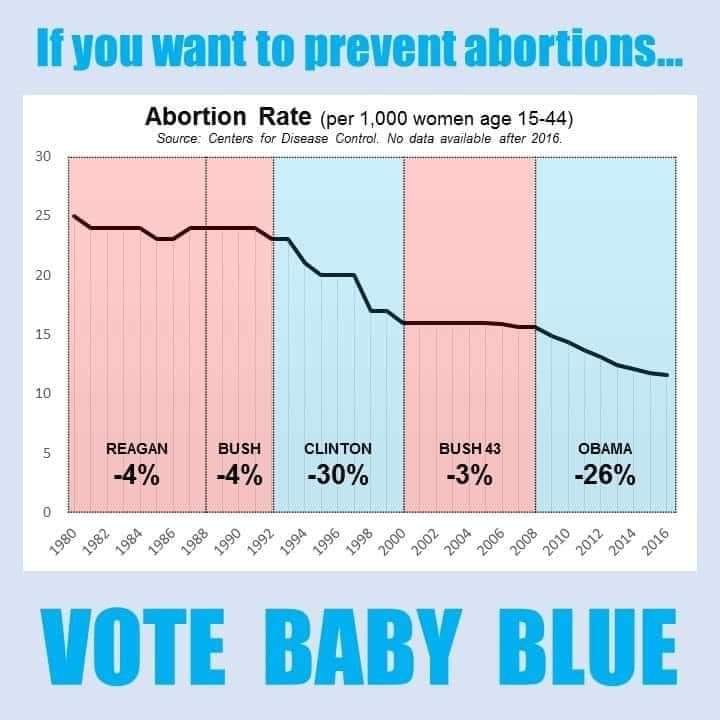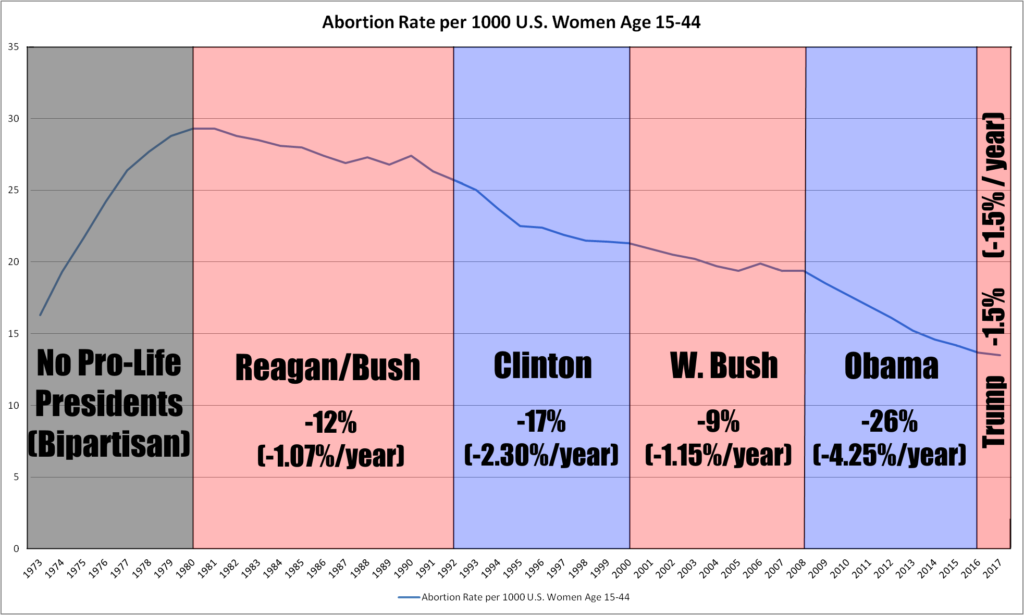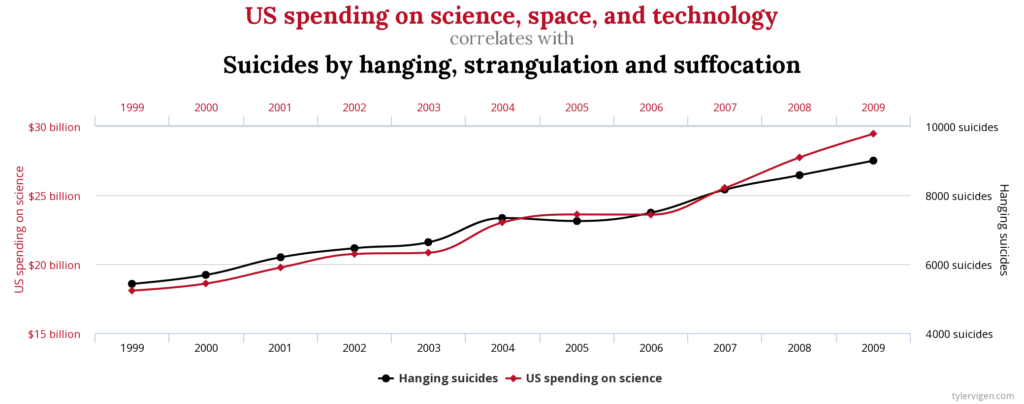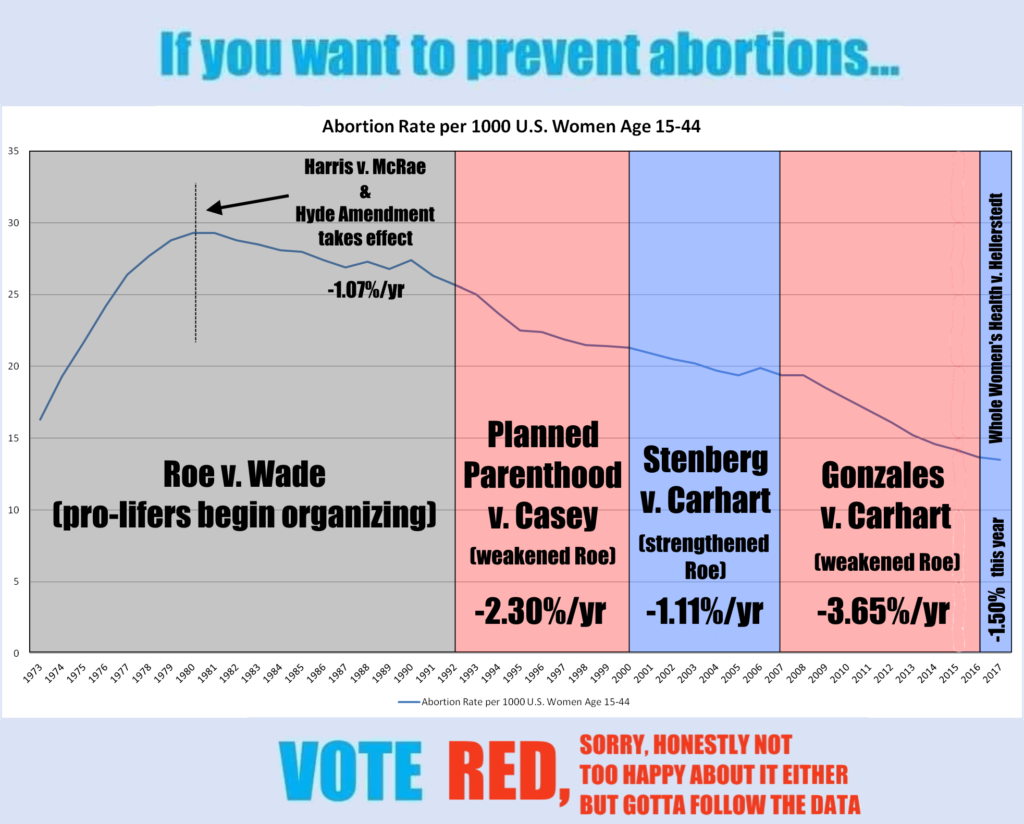Do Presidents Affect Abortion Rates At All?
There’s a chart going around social media that looks like this:

“If you want to prevent abortions, vote baby blue!”
This isn’t a new argument. I started encountering versions of it as early as the 2008 presidential election, and I’m sure some intrepid pioneer tried it out in the 2004 presidential election. “Abortion rates fall faster under Democratic presidents than Republican presidents, like magic, so pro-lifers should support Democrats–or at least feel guilt-free about doing so!”
There are some problems with the data (as PolitiFact points out in that link), but the data can be roughly cleaned up using Guttmacher Institute abortionist census data. (You can’t trust Guttmacher — it’s like trusting ExxonMobil’s studies on climate change — but, in the absence of a federal abortion reporting law, Guttmacher provides the closest thing we have to a consensus reality.) The cleaned-up data shows a pretty similar trend:

Oddly enough, though, very few people ever try to explain how this argument could possibly be true. Even if you buy that President Obama’s social policies drove down the abortion rate by alleviating poverty and reducing demand for abortion, President Obama’s major social policy reforms didn’t pass into law until 2010 and largely didn’t come into effect until 2011 — yet the abortion decline started in the depths of the Great Recession, just as Obama took office! Now that’s some real personal mojo!
This kind of thinking reminds me of other arguments I’ve heard over the years. For example, “If you want to increase U.S. spending on science, space, and technology, encourage more people to commit suicide by hanging!”

Or: “If you want to reduce murders by bodily force, save marriages in Mississippi specifically!”

Actually, though, come to think of it, I’ve never actually heard anyone make those arguments. That’s because they are insane. Sometimes, statistics line up with each other in funny, but entirely spurious, ways.
One way to almost guarantee that you are about to discover a spurious correlation, though, is when you try to associate a complex national trend with a single variable that has no direct impact on the trend at all — a variable like “what letter is next to the name of the guy in the White House.” Yet, somehow, this never stops anyone from trying to use this single variable to explain all kinds of incredibly complex things the President only indirectly and slowly affects, from the economy to war to trade balances to incarceration to the national debt.
Presidents do influence all these things, of course, but they influence them through discrete executive or legislative measures. These usually take place later in their terms, and they take even longer to have effects. Anything bad that happens in the first year of a president’s administration is probably not his fault; anything good that happens in that year is probably not to his credit… and even anything that happens after that first year is only to the president’s blame or credit if the president actually took identifiable actions that influenced it. (Even then, there are probably lots of other factors at work. The President is not supposed to be a monarchy, and even monarchs don’t control everything.)
There are, of course, lots of factors influencing the steady decline in the U.S. abortion rate. The teen pregnancy rate has crashed. Nationally, fewer children are being conceived in the first place. The causes of this are also complex. Democrats often tout their promotion of contraception, and there’s evidence that indicates this does indeed play a role. (On the other hand, growing teen abstinence, not something Democrats are known for promoting, also seems to play a role.) Meanwhile, states continue to tighten the availability of abortion through legislation, independent abortionists continue to close up shop, and the federal government only tightens the spigots on abortion funding.
I’d like to take a look at one of those factors in particular, though: U.S. court rulings on abortion. I think examining this history sheds more light on how abortion law and partisan politics interact with abortion rates in the United States — and it will provide us with an update to the original chart that is somewhat more informative than the original.
Let’s dive into a Brief History of U.S. Court Rulings on Abortion:
1973: In a 7-2 decision, the Supreme Court hands down Roe v. Wade. In conjunction with a companion decision, Doe v. Bolton, Roe and Doe created an unlimited right to abortion-on-demand throughout the United States, up to the moment of birth.
Many Roe supporters, including Roe‘s own authors, insisted that Roe established a “trimester” framework for abortion regulation, but Doe created an exception to that framework that applied to literally anyone, swallowing the “trimester” framework whole.
Notably, a 6-3 majority of Supreme Court justices on the Court at this time were Republican-appointed. (One Republican-appointed justice and one Democrat-appointed justice dissented from Roe.)
It’s unimaginable today that 5 Republican-appointed justices would create an unlimited right to abortion out of constitutional thin air. It’s also unimaginable today that a Democratic-appointed justice would dissent! But the parties back then had not yet polarized on abortion.
The 1970s: The nascent pro-life movement repeatedly tried to overturn Roe v. Wade through judicial appeals and through constitutional amendments. They were repeatedly rebuffed by a bipartisan coalition. Many Democrats who are today anti-unborn were still pro-unborn at this point — including Sen. Joe Biden, who supported a constitutional amendment to overturn Roe. Abortion continued without meaningful limitation.
The single major victory won by unborn advocates during this period was the Hyde Amendment (also supported by Sen. Joe Biden). This funding restriction prevented federal taxpayer dollars from paying for abortions except to save the mother’s life. (A rape exception was not added until 1995.) Although passed in 1977, the Hyde Amendment did not go into effect until the Supreme Court upheld it 5-4 in Harris v. McRae (1980). The Guttmacher Institute finds that the Hyde Amendment reduces the abortion ratio by roughly 25% among Medicaid-eligible women.
(After forty years of relatively strong standing in federal law, the Democratic Party of 2020 has announced its opposition to the Hyde Amendment in its platform, and candidate Joe Biden now opposes Hyde as well.)
The Reagan Years: Abortion becomes politically polarized. Democrats either become anti-unborn or lose their primaries. In 1983, Biden recants his support for the Human Life Amendment. Republicans become pro-unborn. In the states, the unborn-rights movement turns to state legislatures to try to restrict abortion — but, aside from Hyde, the courts strike down nearly all their efforts.
Ronald Reagan was President for most of this decade. He was the first President in history to explicitly make unborn rights part of his platform, and he was also the first in recent history to embrace the idea that the Constitution should be read with its original meaning in mind. He attempted to support both originalism and the unborn through his three Supreme Court appointments.
Reagan’s appointment of originalist, anti-Roe Antonin Scalia (replacing pro-Roe Republican Warren Burger) went swimmingly.
Reagan’s appointment of Sandra Day O’Connor (replacing pro-Roe Republican Potter Stewart) misfired. Believed to be an originalist, therefore almost by definition anti-Roe, O’Connor turned out to be more of a pragmatist once in office. She was inclined to weaken Roe, but not to overturn it. Reagan’s error is understandable: O’Connor’s appointment came in 1981, when originalism was still just getting off the ground. There was no known pool of originalist judges, and no one existed to vet them; the Federalist Society would not even be founded until 1982.
Finally, Reagan nominated the highly-qualified Robert Bork (to replace pro-Roe Republican Lewis Powell), but newly pro-choice Democrats like Ted Kennedy, citing Bork’s anti-Roe tendencies (among other things), rejected him as unfit. Reagan’s follow-up nominee, Douglas Ginsburg, was also a sterling candidate, but NPR’s Nina Totenberg dug up the totally damning dirt that Ginsburg had (GASP!!!) smoked pot a few times 20-30 years earlier. Outraged Democrats would no longer provide the votes to get Ginsburg through the Senate. So Reagan was forced to nominate Anthony Kennedy, who turned out to be a garbage fire as a justice and joined O’Connor as a second vote to weaken Roe without overturning it.
The H.W. Bush Years: President Bush continued Reagan’s judicial project, with similar mixed success. (He also successfully defended the Rust v. Sullivan regulations defunding Planned Parenthood.)
For his first vacancy (replacing pro-Roe Republican Brennan), Bush wanted to avoid a Bork-style fight against Democrats, who still controlled the Senate. Instead, Bush appointed someone with good credentials, whom his administration could vouch for… but who had virtually no paper trail for the Senate to scrutinize and attack. This was called the “stealth bomber” strategy, it made sense at the time, and it worked. Unfortunately, it backfired: the Bush Administration’s vetting process had failed, and Justice David Souter went on to become one of the staunchest anti-originalist, pro-Roe voices on the Supreme Court.
For his second vacancy (replacing pro-Roe Democrat Thurgood Marshall), Bush nominated Clarence Thomas, who barely survived his Senate hearings in the face of hostile Democratic opposition — but did ultimately reach the Court as an anti-Roe justice.
After over a decade in power, two Republican presidents had appointed five Supreme Court justices. Two were anti-Roe. Two wanted to weaken Roe. And one supported Roe.
However, supporters of the “Republicans don’t actually want to end abortion” thesis should take note: Republicans were pushed into two of their three mistakes (Kennedy and Souter) by implacable Democratic support for abortion, and one of their successes (Thomas) only barely overcame that same Democratic devotion to abortion rights.
The Court now had 3 pro-Roe members, 4 anti-Roe members, and 2 members who wanted to weaken Roe but retain it. Even though Roe would not be overturned, Reagan and Bush had still won a huge prize for the unborn-rights movement, because Roe was about to get weakened.
1992: The Supreme Court’s Planned Parenthood v. Casey decision effectively replaced Roe v. Wade as the controlling American law on abortion. Loathed by pro-lifers and pro-choicers alike, Casey maintained the notion of a constitutional right to abortion, but, for the first time, allowed states to pass modest disincentives against it (like waiting periods)… as long as they didn’t impose an “undue burden” on abortion access.
If Senate Democrats had not blocked Robert Bork, Roe would have ended that day.
But, as it was, the decision finally opened a viable avenue for pro-lifers to enact at least some protections for the unborn.
That same year, Bill Clinton won the election, ending twelve years of Republicans in the White House.
The Clinton Years: President Clinton moves against the unborn as quickly as possible. He immediately unlocks the funding that Bush and Reagan had defended in Rust v. Sullivan, restarts funding for abortions overseas, and vetoes all pro-unborn legislation that crosses his desk. This includes even the overwhelmingly popular and bipartisan Partial-Birth Abortion Ban Act, which Clinton vetoes twice. Congress nearly overrides Clinton’s veto, but a minority of Democrats kills the bill.
However, Clinton can do nothing about the states, and Casey has just given activists new running room in the states. They start passing restrictions with gusto, regulating some clinics to the point of minimizing or closing them, while finding ways to promote the idea in law that unborn people are people, too.
Clinton counters their successes with Supreme Court appointments of his own. He makes no mistakes. Pro-Roe Ruth Bader Ginsburg replaces anti-Roe Democrat Byron White, and pro-Roe Justice Breyer replaces pro-Roe Republican Harry Blackmun. The Senate, still under Democratic control, embraces both, and Republicans offer no resistance through filibuster. The court shifts to 4-3 pro/anti Roe, with 2 swing justices who want to keep Roe in a limited way.
This shift pays off for Clinton just as he is about to leave office.
2000: The Supreme Court’s Stenberg v. Carhart decision rules 5-4 that late-term abortion bans are unconstitutional unless they contain a “life or health” exception for the mother. The “health” part is problematic, because that is the same, very vague exception that Doe v. Bolton used to bypass all limitations on abortion under the original Roe framework. Effectively, Stenberg declares that even modest restrictions on abortion procedures are unconstitutional. (Sandra Day O’Connor splits from Anthony Kennedy to join the Clinton-enlarged pro-Roe wing in this decision.)
The effect of Stenberg is that the wheels of pro-life progress grind down to a crawl. By this time, much of the low-hanging fruit for state-level restrictions on abortion has been picked, and Stenberg makes it impossible for states to go much further, even to ban extremely unpopular late-term abortions.
The Bush Years: Bush paid his chits to the pro-life movement by appointing two well-vetted textualist judges to the Supreme Court (Roberts, replacing the “swing justice” O’Connor, and Alito, replacing the anti-Roe Rhenquist). This seemingly left the court tied 4-4 on Roe, with Kennedy as swing justice.
Bush then finally passed the Partial-Birth Abortion Ban Act with bipartisan support in 2003, setting up a direct challenge to Stenberg v. Carhart.
Bush also passed the Unborn Victims of Violence Act, the first federal law recognizing the personal rights of unborn persons.
2007: After nearly four years of litigation, the Supreme Court finally ruled on the Partial-Birth Abortion Act — and Bush’s work paid off. Roberts joined the dissenters in Stenberg to make a 5-4 majority to uphold the Act and effectively overturn Stenberg.
This unlocked the engines of pro-life innovation in the states once again. Unfortunately for President Bush, his term was nearly over. His labors would not bear fruit until the next administration.
The Obama Years: President Obama reinforced the pro-Roe side of the Court by replacing two pro-Roe justices (Souter and John Paul Stevens) with two more pro-Roe justices (Sotomayor and Kagan). Because a Democrat was President, the Court remained 4-4-1 on Roe (with Kennedy as the swing justice), rather than becoming 6-2-1 or 5-2-2 anti-Roe. On the other hand, because Republicans held the Senate, Obama was unable to seat presumptively pro-Roe Merrick Garland to replace anti-Roe Scalia, preserving the 4-4-1 balance.
Obama’s nominations paid off when the Court handed down Whole Women’s Health v. Hellerstedt in 2016. Kennedy joined the pro-Roe wing this time. This decision put a stop to a wave of pro-unborn legislation in the states.
But it was a bit late for that. Thanks to Gonzales, red states had become more aggressive in regulating abortion, and the Republican wave of 2010 made a lot more states red from 2011 forward. By the time Whole Women’s Health came out, Obama’s term was nearly over. Hundreds of clinics were closed, abortion rates were down substantially, and (depending on how you calculate it) tens or hundreds of thousands of lives had been saved.
These children, regrettably, owe their lives to the Republican Party. The once-great caucus of pro-life Democrats, which had been slowly marginalized since the 80s, were made virtually extinct during the Obama Administration. Only a handful (like the great John Bel Edwards) survived.
The Trump Years: We have very little data so far on the Trump years.
We know that President Trump has worked hard to tighten federal restrictions on taxpayer abortion funding, and he has opened a few regulatory options to states that weren’t available under Obama. We know that Trump has nominated three Supreme Court justices, but we haven’t seen any of the nominees squarely face the issue of Roe. Gorsuch and (presumptive justice) Barrett are almost certainly anti-Roe. Kavanaugh’s position is less clear. We know state legislatures have been creative about working around Whole Women’s Health — and about challenging it directly.
We also know that Roberts has politicized the Court’s rulings in recent years, issuing some rulings based on pleasing certain political constituencies, not on obeying the law of the land. In 2020, the Court ruled in June Medical Services v. Russo that Whole Women’s Health should be reaffirmed… only now, with Kennedy gone, Roberts joined the Democratic appointees. According to the John Roberts confirmed in 2005, that should not have happened. (I stood by Roberts a long time, but June Medical Services made it impossible.) Roberts’ swing to the Dark Side in June Medical is the first time the “Republican judges will never overturn Roe” got a real point in its favor. Finally, we know that chemically induced abortions, using drugs administered at home like RU-486, are on the rise, potentially working around the closure of clinics and other restrictions.
But it will be a while before enough data is collected on abortion during these years for us to know what actually happened to the abortion rate between 2017 and 2020.
I would be surprised if the abortion rate continued falling at the same pace as during the Obama years — the years between Gonzales and Whole Women’s Health. I suspect the rate of decline will slow, or even reverse. That’s the legacy of the Obama Administration, the Clinton Administration, and the Democrats’ rejection of Robert Bork. They provided all five of the votes in WWH.
So here’s a better version of the original chart. Instead of asking, “Which party is in the White House?” we ask “Which party’s appointees brought about the last major Supreme Court decision on abortion?” (We ignore all appointees before 1980, when the pro-life movement first had a say in justices.) This revision gets us something like this:

As I noted at the top, there are lots of stories you can tell about the decline in the abortion rate, and lots of them are true. It’s a complex issue.
There’s almost certainly some truth in this revised chart. (There is very little, if any, in the original.) We have good, solid demonstrations going back thirty years that incremental pro-life legislation passed at the state level reduces abortions, and we can clearly associate favorable court rulings with new waves of pro-life legislation. We know that restriction and abolition work: there is probably no faster way to reduce the abortion rate than outlawing abortion. (See above; also here and here, among others.) It should be surprising to absolutely no one that waves of anti-abortion legislation following favorable court rulings were soon followed by faster declines in the abortion rate. And those favorable court rulings–even the weak ones–are all owed to judges appointed by Republican presidents.
For all their faults, Republican presidents, senators, and state legislators have saved countless thousands by their vigilant opposition to abortion… and many of their greatest gains have come while a Democrat in the White House was still working to undo a predecessor’s protections for the unborn. Lots of these reductions could not have come about if Democrats had held the White House for longer — and Democratic proposals like abolishing state-level restrictions and repealing the Hyde Amendment would certainly increase the abortion rate, as even Guttmacher recognizes. By contrast, Republicans would almost certainly have achieved deeper reductions in the abortion rate if they had held office longer, with a freer hand to appoint more judges and pass more laws without anti-unborn Democrat opposition.
Republicans use pro-lifers cynically for votes, of course. This is obvious. They count on our votes, then pay us back verrrrrry slowly. President Trump may be the most cynical of the bunch.
But nobody uses pro-lifers for votes more cynically than Democrats. The handful of talking points they give out to defend the crazy idea that “we should vote for people who hate unborn rights to help the unborn somehow” don’t stand up to even casual scrutiny.
Professor William Cavanaugh made a similar argument in America this year (roughly: “Republicans have been trying to end abortion for fifty years, they’ve failed, and abortion rates decline regardless of who is in office, so it is time to stop voting based on abortion”), but Cavanaugh’s argument falls apart with the slightest knowledge of the history of the nominations process, or any knowledge of abortion laws favored by the Democrats and thus far blocked by Republicans. Marginalizing a toxic ideology that dominates the Supreme Court is a decades-long project (assuming you don’t take shortcuts like court-packing, which I suppose Cavanaugh thinks Republicans should have done in 2005). Nobody should be surprised that it’s taking this long — especially when too many pro-unborn voters turn around and vote for anti-unborn candidates, who vow to appoint anti-unborn judges, who then reverse many of our gains!
I can understand the temptation to be taken in by those wafer-thin “pro-life left” talking points. President Trump is awful, and has been for four years. The Republican Party has been in bad shape for much longer than that. Alasdair MacIntyre, the great ethicist, condemned voting for either party starting way back in 2004. I myself do not plan vote for either major-party presidential candidate this year, largely for the reasons Brandon McGinley lays out at The Public Discourse, with a small side-order of “I won’t spend down my small stockpile of credibility to shore up the losing campaign of a vicious, lying adulterer who should have been impeached.”
Yet it is a hard truth that, based on the evidence, Republican abortion policies have likely prevented tens to hundreds of thousands of fetal killings. I will be voting for Republicans for Senate and House, even Jason Lewis, whom I loathe. If, knowing all I have just said, you choose to be taken in by the facile “Democrats reduce abortions” argument anyway, and throw your lot in with them (instead of abstaining)… then I can only imagine that you will eventually have to explain that decision to the children who died because you chose to cooperate with their killers. I hope your reasons are truly proportionate.
I have made the data used in this post available on a Google Sheet.
